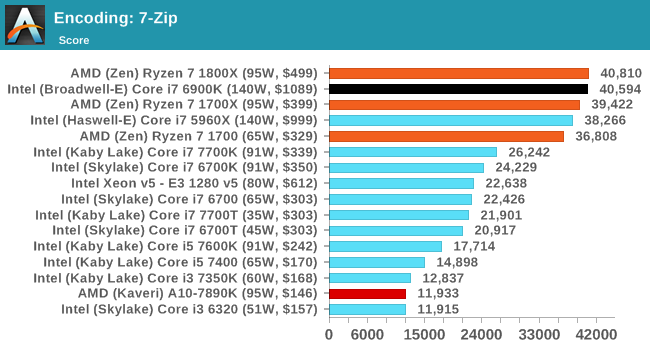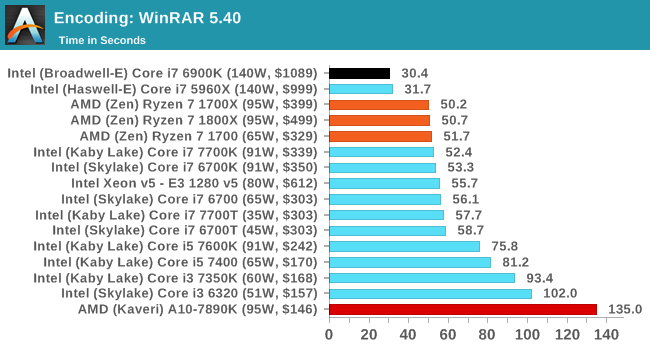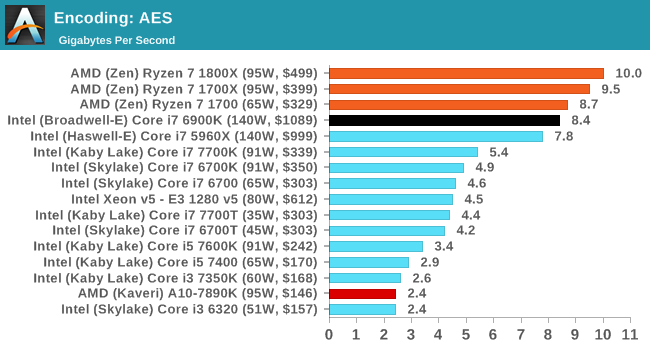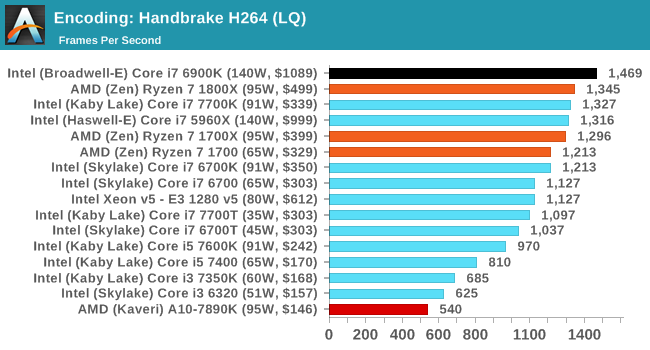The AMD Zen and Ryzen 7 Review: A Deep Dive on 1800X, 1700X and 1700
by Ian Cutress on March 2, 2017 9:00 AM ESTBenchmarking Performance: CPU Encoding Tests
One of the interesting elements on modern processors is encoding performance. This includes encryption/decryption, as well as video transcoding from one video format to another. In the encrypt/decrypt scenario, this remains pertinent to on-the-fly encryption of sensitive data - a process by which more modern devices are leaning to for software security. Video transcoding as a tool to adjust the quality, file size and resolution of a video file has boomed in recent years, such as providing the optimum video for devices before consumption, or for game streamers who are wanting to upload the output from their video camera in real-time. As we move into live 3D video, this task will only get more strenuous, and it turns out that the performance of certain algorithms is a function of the input/output of the content.
7-Zip
One of the freeware compression tools that offers good scaling performance between processors is 7-Zip. It runs under an open-source licence, is fast, and easy to use tool for power users. We run the benchmark mode via the command line for four loops and take the output score.

WinRAR 5.40
For the 2017 test suite, we move to the latest version of WinRAR in our compression test. WinRAR in some quarters is more user friendly that 7-Zip, hence its inclusion. Rather than use a benchmark mode as we did with 7-Zip, here we take a set of files representative of a generic stack (33 video files in 1.37 GB, 2834 smaller website files in 370 folders in 150 MB) of compressible and incompressible formats. The results shown are the time taken to encode the file. Due to DRAM caching, we run the test 10 times and take the average of the last five runs when the benchmark is in a steady state.

AES Encoding
Algorithms using AES coding have spread far and wide as a ubiquitous tool for encryption. Again, this is another CPU limited test, and modern CPUs have special AES pathways to accelerate their performance. We often see scaling in both frequency and cores with this benchmark. We use the latest version of TrueCrypt and run its benchmark mode over 1GB of in-DRAM data. Results shown are the GB/s average of encryption and decryption.

HandBrake H264 and HEVC
As mentioned above, video transcoding (both encode and decode) is a hot topic in performance metrics as more and more content is being created. First consideration is the standard in which the video is encoded, which can be lossless or lossy, trade performance for file-size, trade quality for file-size, or all of the above can increase encoding rates to help accelerate decoding rates. Alongside Google's favorite codec, VP9, there are two others that are taking hold: H264, the older codec, is practically everywhere and is designed to be optimized for 1080p video, and HEVC (or H265) that is aimed to provide the same quality as H264 but at a lower file-size (or better quality for the same size). HEVC is important as 4K is streamed over the air, meaning less bits need to be transferred for the same quality content.
Handbrake is a favored tool for transcoding, and so our test regime takes care of three areas.
Low Quality/Resolution H264: He we transcode a 640x266 H264 rip of a 2 hour film, and change the encoding from Main profile to High profile, using the very-fast preset.

High Quality/Resolution H264: A similar test, but this time we take a ten-minute double 4K (3840x4320) file running at 60 Hz and transcode from Main to High, using the very-fast preset.

HEVC Test: Using the same video in HQ, we change the resolution and codec of the original video from 4K60 in H264 into 1080p30 HEVC. This causes a dramatic reduction in filesize.











574 Comments
View All Comments
Cooe - Sunday, February 28, 2021 - link
Absolute nonsense. Game code is optimized specifically for the Intel Core pipeline & ESPECIALLY it's ring bus interconnect. There's no such thing as "optimizing for x86". Code is either written with the x86 ISA or its not...FriendlyUser - Thursday, March 2, 2017 - link
The 1700X with a premium motherboard is cheaper and faster than the 6850K. If you absolutely need the extra PCIe lanes or the 8 DIMM slots, then x99 is better, otherwise you are getting less perf/$.mapesdhs - Thursday, March 2, 2017 - link
Or a used X79. I'm still rather surprised how close my 3930K/4.8 results are to the tests results shown here (CB10/ST = 7935, CB10/MT = 42389 , CB11.5/MT = 13.80, CB R15 MT = 1241). People are selling used 3930Ks for as little as 80 UKP now, though finding a decent mbd is a bit more tricky.I have an ASUS R5E/6850K setup to test, alongside a used-parts ASYS P9X79-E WS/4960X which cost scarily less than the new X99 setup, it'll be interesting to see how these behave against the KL/BW-E/Ryzen numbers shown here.
Ian.
Aerodrifting - Thursday, March 2, 2017 - link
"$500 1800x is still too expensive. According to this even a 7700k @ $300 -$350 is still a good choice for gamers."Same thing can be said for every Intel extreme platform processors, $1000 5960X/6900K is still too expensive, $1600 6950X is too expensive, Because 7700K is better for gaming.
Then you said "2011-v3 still offers a platform with more PCIe3 lanes and quad memory channel. ", Which directly contradict what you said earlier about gaming, How does more PCIe3 lanes and quad channel memory improve your FPS when video cards run fine with x8.
Your are too idiotic to even run coherent argument.
lmcd - Thursday, March 2, 2017 - link
What on earth are you talking about? PCIe3 lanes and quad channel memory are helpful for prosumer workloads. It's not contradictory at all?mapesdhs - Thursday, March 2, 2017 - link
Yup, quad GPU for After Effects RT3D, and fast RAM makes quite a difference.Notmyusualid - Friday, March 3, 2017 - link
@mapesdhs:Indeed.
Also, I can actually 'feel' the difference going from dual to quad channel ram performance.
I checked, and I hadn't correctly seated one of my four 16GB modules...
Shutdown, reseat, reboot, and it 'felt' faster again.
Aerodrifting - Thursday, March 2, 2017 - link
Learn to read a complete sentence please."nos024" was complaining gaming performance, Then he pulled out extra PCIe3 lanes and quad channel memory to defend X99 platform even though they were also inferior to 7700K in gaming (just like Ryzen). That makes him sound like a completely moron, Because games don't care about those extra PCIe lane or quad channel memory.
Notmyusualid - Friday, March 3, 2017 - link
X99 'inferior'?I just popped over the 3dmark11's results page, selected GPU as 1080, and I had to scroll down to 199th place (a 7700k clocked to a likely LN2 5.8GHz), to find a system that wasn't triple, or quad channel equipped.
Here: http://www.3dmark.com/search#/?url=/proxycon/ajax/...
So I guess those lanes don't help us multip-gpu people after all?
Swallow.
Aerodrifting - Saturday, March 4, 2017 - link
Because 3Dmark11 hall of fame ranking equals real life gaming performance.Are you a moron or just trolling? Everyone knows when it comes to gaming, A high frequency i7 (such as 7700K) beats everything else, Including 8 core Ryzen or 10 core i7 extreme 6950X.